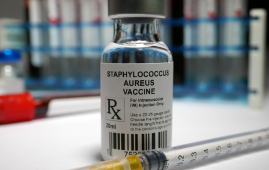

Researchers from the University of Saint Andrews have developed a new tuberculosis (TB) therapy that has the potential to save millions of lives by cutting the length of the disease’s treatment by up to two months.
On Monday, February 20, at the 30th annual Conference on Retroviruses and Opportunistic Infections (CROI) in Seattle, Dr. Muge Cevik, a clinical academic in infectious diseases and medical virology based in the Infections and Global Health Research Division of the School of Medicine at St Andrews, presented the findings of the SimpliciTB clinical trial conducted by the global TB Alliance.
Every year, over 1 million people die from tuberculosis. New instruments and new therapies are necessary to reverse this and save lives. The most drug-sensitive forms of TB require at least four months of treatment with four anti-TB agents. Active TB must be treated with a combination of medications. The World Health Organization (WHO) estimates that 1.6 million people worldwide passed away from tuberculosis (TB) in 2021, while exact figures are unknown and current research indicates that there may have been many more deaths.
The BPaMZ regimen, which consists of bedaquiline (B), pretomanid (Pa), moxifloxacin (M), and pyrazinamide, was evaluated in the global SimpliciTB study (Z). In both preclinical analyses and an early-stage clinical investigation with patients who were resistant to drugs, this combination previously demonstrated great efficacy and the ability to decrease treatment times.
In 26 sites in eight nations (South Africa, Tanzania, Georgia, Brazil, Russia, the Philippines, Uganda, and Malaysia), SimpliciTB enrolled 455 patients with drug-susceptible (DS) or drug-resistant (DR) tuberculosis (TB). The objective of the clinical trial was to assess the efficacy and safety of BPaMZ in individuals with either DS-TB or DR-TB.
The trial’s findings, which were reported at CROI, demonstrated that the BPaMZ regimen was very effective against the TB bacterium and that it achieved its primary aim by making DS-TB subjects 2.93 times more likely to convert their cultures by week eight. The secondary endpoint of noninferiority in percent positive outcomes compared to six months of HRZE in DS-TB was not, however, met by the four-month experimental BPaMZ regimen. This was brought on by problems with adherence; about 10% of individuals receiving treatment under the BPaMZ arms stopped because of side effects.
“Recent progress in tuberculosis therapeutics has been limited, with few new drug classes emerging in the last 50 years,” said Dr. Muge Cevik. Innovative clinical trials like SimpliciTB help us better understand how novel drug regimens work against both drug-sensitive and drug-resistant TB, lighting the way to better treatment options for all TB patients.
10 million people contracted TB in 2021, and 1.6 million people passed away from it. A treatment-resistant strain of the illness is thought to infect 500,000 people annually, and in some areas, up to 40% of all cases may be drug resistant. To help stop the spread of TB, novel medication regimens are desperately needed.
Drug-resistant tuberculosis (DR-TB) manifests when the lengthy, intricate, decades-old TB drug regimen is administered incorrectly or when individuals get TB from those who have the drug-resistant disease, underscoring the urgent need for improved and more efficient treatment regimens. In 2021, only an estimated one-third of individuals with drug-resistant tuberculosis received treatment.
The Infection and Global Health Research Division at the University of St Andrews work in a wide range of fields that includes clinical trials, genetics, anti-microbial resistance, diagnostic tools, education, and global health policy. Professor Stephen Gillespie, leader of the infection group at St Andrews, said, “This study shows the value of St Andrews world-leading partnership working with international collaborators and the TB Alliance. Together, we have a sustained commitment to develop new and better treatments for tuberculosis which remains a threat to human health globally.”
Dr. Derek Sloan, senior lecturer in the School of Medicine involved in the global trial added, “The trial suggests that new antibiotic combinations can kill all types of TB bacteria faster than traditional approaches, which is exciting. However, as we find new options to improve TB treatment, we still need to work out which therapies are most suitable for each individual patient.
“Future work will include more detailed investigation of which anti-TB antibiotics work best together. Future considerations will include patient safety and the complex logistics of how to implement new treatment strategies across the diverse range of settings where TB is a major threat to health, worldwide.”
The TB Alliance plans to submit data from SimpliciTB to a peer-reviewed publication. The TB Alliance is a not-for-profit organization dedicated to the discovery, development, and delivery of better, faster-acting, and affordable tuberculosis drugs that are available to those who need them.
more recommended stories
 Innovative AI Boosts Epilepsy Seizure Prediction by 44%
Innovative AI Boosts Epilepsy Seizure Prediction by 44%Transforming Seizure Prediction in Epilepsy Seizure.
 Hypnosis Boosts NIV Tolerance in Respiratory Failure
Hypnosis Boosts NIV Tolerance in Respiratory FailureA New Approach: Hypnosis Improves NIV.
 Bee-Sting Microneedle Patch for Painless Drug Delivery
Bee-Sting Microneedle Patch for Painless Drug DeliveryMicroneedle Patch: A Pain-Free Alternative for.
 AI Reshapes Anticoagulation in Atrial Fibrillation Care
AI Reshapes Anticoagulation in Atrial Fibrillation CareUnderstanding the Challenge of Atrial Fibrillation.
 Hemoglobin as Brain Antioxidant in Neurodegenerative Disease
Hemoglobin as Brain Antioxidant in Neurodegenerative DiseaseUncovering the Brain’s Own Defense Against.
 Global Data Resource for Progressive MS Research (Multiple Sclerosis)
Global Data Resource for Progressive MS Research (Multiple Sclerosis)The International Progressive MS Alliance has.
 AI Diabetes Risk Detection: Early T2D Prediction
AI Diabetes Risk Detection: Early T2D PredictionA new frontier in early diabetes.
 Cancer Cells Learn to Self-Report: A New Frontier in Immunotherapy
Cancer Cells Learn to Self-Report: A New Frontier in ImmunotherapyHow a Drug Complex Enables Immune.
 Staphylococcus Shows Complex Enzyme Redundancy, Study Finds
Staphylococcus Shows Complex Enzyme Redundancy, Study FindsA Bacterial Pathogen That Refuses to.
 Parkinson’s Disease Care Advances with Weekly Injectable
Parkinson’s Disease Care Advances with Weekly InjectableA new weekly injectable formulation of.

Leave a Comment